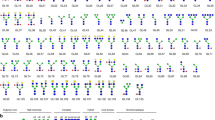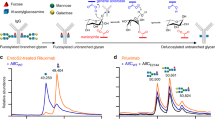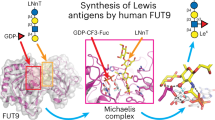Abstract
Protein O-fucosyltransferase 2 (POFUT2) is an essential enzyme that fucosylates serine and threonine residues of folded thrombospondin type 1 repeats (TSRs). To date, the mechanism by which this enzyme recognizes very dissimilar TSRs has been unclear. By engineering a fusion protein, we report the crystal structure of Caenorhabditis elegans POFUT2 (CePOFUT2) in complex with GDP and human TSR1 that suggests an inverting mechanism for fucose transfer assisted by a catalytic base and shows that nearly half of the TSR1 is embraced by CePOFUT2. A small number of direct interactions and a large network of water molecules maintain the complex. Site-directed mutagenesis demonstrates that POFUT2 fucosylates threonine preferentially over serine and relies on folded TSRs containing the minimal consensus sequence C-X-X-S/T-C. Crystallographic and mutagenesis data, together with atomic-level simulations, uncover a binding mechanism by which POFUT2 promiscuously recognizes the structural fingerprint of poorly homologous TSRs through a dynamic network of water-mediated interactions.
This is a preview of subscription content, access via your institution
Access options
Subscribe to this journal
Receive 12 print issues and online access
$259.00 per year
only $21.58 per issue
Buy this article
- Purchase on Springer Link
- Instant access to full article PDF
Prices may be subject to local taxes which are calculated during checkout




Similar content being viewed by others
References
Hurtado-Guerrero, R. & Davies, G.J. Recent structural and mechanistic insights into post-translational enzymatic glycosylation. Curr. Opin. Chem. Biol. 16, 479–487 (2012).
Moremen, K.W., Tiemeyer, M. & Nairn, A.V. Vertebrate protein glycosylation: diversity, synthesis and function. Nat. Rev. Mol. Cell Biol. 13, 448–462 (2012).
Luther, K.B. & Haltiwanger, R.S. Role of unusual O-glycans in intercellular signaling. Int. J. Biochem. Cell Biol. 41, 1011–1024 (2009).
Sakaidani, Y. et al. O-linked-N-acetylglucosamine on extracellular protein domains mediates epithelial cell-matrix interactions. Nat. Commun. 2, 583 (2011).
Lombard, V., Golaconda Ramulu, H., Drula, E., Coutinho, P.M. & Henrissat, B. The carbohydrate-active enzymes database (CAZy) in 2013. Nucleic Acids Res. 42, D490–D495 (2014).
Vasudevan, D. & Haltiwanger, R.S. Novel roles for O-linked glycans in protein folding. Glycoconj. J. 31, 417–426 (2014).
Luca, V.C. et al. Structural biology. Structural basis for Notch1 engagement of Delta-like 4. Science 347, 847–853 (2015).
Vasudevan, D., Takeuchi, H., Johar, S.S., Majerus, E. & Haltiwanger, R.S. Peters plus syndrome mutations disrupt a noncanonical ER quality-control mechanism. Curr. Biol. 25, 286–295 (2015).
Takeuchi, H. & Haltiwanger, R.S. Significance of glycosylation in Notch signaling. Biochem. Biophys. Res. Commun. 453, 235–242 (2014).
Taylor, P. et al. Fringe-mediated extension of O-linked fucose in the ligand-binding region of Notch1 increases binding to mammalian Notch ligands. Proc. Natl. Acad. Sci. USA 111, 7290–7295 (2014).
Chen, C.I. et al. Structure of human POFUT2: insights into thrombospondin type 1 repeat fold and O-fucosylation. EMBO J. 31, 3183–3197 (2012).
Lira-Navarrete, E. et al. Structural insights into the mechanism of protein O-fucosylation. PLoS One 6, e25365 (2011).
Yan, C., Wu, F., Jernigan, R.L., Dobbs, D. & Honavar, V. Characterization of protein-protein interfaces. Protein J. 27, 59–70 (2008).
Tan, K. et al. Crystal structure of the TSP-1 type 1 repeats: a novel layered fold and its biological implication. J. Cell Biol. 159, 373–382 (2002).
Lairson, L.L., Henrissat, B., Davies, G.J. & Withers, S.G. Glycosyltransferases: structures, functions, and mechanisms. Annu. Rev. Biochem. 77, 521–555 (2008).
Ricketts, L.M., Dlugosz, M., Luther, K.B., Haltiwanger, R.S. & Majerus, E.M. O-fucosylation is required for ADAMTS13 secretion. J. Biol. Chem. 282, 17014–17023 (2007).
Wang, L.W. et al. O-fucosylation of thrombospondin type 1 repeats in ADAMTS-like-1/punctin-1 regulates secretion: implications for the ADAMTS superfamily. J. Biol. Chem. 282, 17024–17031 (2007).
Lira-Navarrete, E. et al. Substrate-guided front-face reaction revealed by combined structural snapshots and metadynamics for the polypeptide N-acetylgalactosaminyltransferase2. Angew. Chem. Int. Edn Engl. 53, 8206–8210 (2014).
Gonzalez de Peredo, A. et al. C-mannosylation and O-fucosylation of thrombospondin type 1 repeats. Mol. Cell. Proteomics 1, 11–18 (2002).
Sun, T., Lin, F.H., Campbell, R.L., Allingham, J.S. & Davies, P.L. An antifreeze protein folds with an interior network of more than 400 semi-clathrate waters. Science 343, 795–798 (2014).
Parsegian, V.A., Rand, R.P. & Rau, D.C. Macromolecules and water: probing with osmotic stress. Methods Enzymol. 259, 43–94 (1995).
Rajapaksha, A., Stanley, C.B. & Todd, B.A. Effects of macromolecular crowding on the structure of a protein complex: a small-angle scattering study of superoxide dismutase. Biophys. J. 108, 967–974 (2015).
Naidoo, K.J. & Kuttel, M. Water structure about the dimer and hexamer repeat units of amylose from molecular dynamics computer simulations. J. Comput. Chem. 22, 445–456 (2001).
Soper, A.K. The radial distribution functions of water and ice from 220 to 673 K and at pressures up to 400 MPa. Chem. Phys. 258, 121–137 (2000).
Andersson, C. & Engelsen, S.B. The mean hydration of carbohydrates as studied by normalized two-dimensional radial pair distributions. J. Mol. Graph. Model. 17, 101–105, 131–133 (1999).
Ball, P. Water as an active constituent in cell biology. Chem. Rev. 108, 74–108 (2008).
Sahún-Roncero, M. et al. The mechanism of allosteric coupling in choline kinase α1 revealed by the action of a rationally designed inhibitor. Angew. Chem. Int. Edn Engl. 52, 4582–4586 (2013).
Kabsch, W. Xds. Acta Crystallogr. D Biol. Crystallogr. 66, 125–132 (2010).
Winn, M.D. et al. Overview of the CCP4 suite and current developments. Acta Crystallogr. D Biol. Crystallogr. 67, 235–242 (2011).
Collaborative Computational Project, Number 4. The CCP4 suite: programs for protein crystallography. Acta Crystallogr. D Biol. Crystallogr. 50, 760–763 (1994).
Emsley, P. & Cowtan, K. Coot: model-building tools for molecular graphics. Acta Crystallogr. D Biol. Crystallogr. 60, 2126–2132 (2004).
Murshudov, G.N. et al. REFMAC5 for the refinement of macromolecular crystal structures. Acta Crystallogr. D Biol. Crystallogr. 67, 355–367 (2011).
Luo, Y., Nita-Lazar, A. & Haltiwanger, R.S. Two distinct pathways for O-fucosylation of epidermal growth factor-like or thrombospondin type 1 repeats. J. Biol. Chem. 281, 9385–9392 (2006).
Lira-Navarrete, E. et al. Dynamic interplay between catalytic and lectin domains of GalNAc-transferases modulates protein O-glycosylation. Nat. Commun. 6, 6937 (2015).
Horcas, I. et al. WSXM: a software for scanning probe microscopy and a tool for nanotechnology. Rev. Sci. Instrum. 78, 013705 (2007).
Lostao, A., Peleato, M.L., Gómez-Moreno, C. & Fillat, M.F. Oligomerization properties of FurA from the cyanobacterium Anabaena sp. PCC 7120: direct visualization by in situ atomic force microscopy under different redox conditions. Biochim. Biophys. Acta 1804, 1723–1729 (2010).
Marcuello, C., Arilla-Luna, S., Medina, M. & Lostao, A. Detection of a quaternary organization into dimer of trimers of Corynebacterium ammoniagenes FAD synthetase at the single-molecule level and at the in cell level. Biochim. Biophys. Acta 1834, 665–676 (2013).
Leonhard-Melief, C. & Haltiwanger, R.S. O-fucosylation of thrombospondin type 1 repeats. Methods Enzymol. 480, 401–416 (2010).
Al-Shareffi, E. et al. 6-alkynyl fucose is a bioorthogonal analog for O-fucosylation of epidermal growth factor-like repeats and thrombospondin type-1 repeats by protein O-fucosyltransferases 1 and 2. Glycobiology 23, 188–198 (2013).
Case, D.A. et al. AMBER 14. (University of California, San Francisco, 2014).
Kirschner, K.N. et al. GLYCAM06: a generalizable biomolecular force field. Carbohydrates. J. Comput. Chem. 29, 622–655 (2008).
Bayly, C.I., Cieplak, P., Cornell, W. & Kollman, P.A. A well-behaved electrostatic potential based method using charge restraints for deriving atomic charges: the RESP model. J. Phys. Chem. 97, 10269–10280 (1993).
Frisch, M.J. et al. Gaussian 09, Revision D.01. (Gaussian, Inc., Wallingford, CT, 2009).
Jorgensen, W.L., Chandrasekhar, J., Madura, J.D., Impey, R.W. & Klein, M.L. Comparison of simple potential functions for simulating liquid water. J. Chem. Phys. 79, 926–935 (1983).
Hornak, V. et al. Comparison of multiple Amber force fields and development of improved protein backbone parameters. Proteins 65, 712–725 (2006).
Andrea, T.A., Swope, W.C. & Andersen, H.C. The role of long ranged forces in determining the structure and properties of liquid water. J. Chem. Phys. 79, 4576–4584 (1983).
Darden, T., York, D. & Pedersen, L. Particle mesh Ewald: An N·log(N) method for Ewald sums in large systems. J. Chem. Phys. 98, 10089–10092 (1993).
Pettersen, E.F. et al. UCSF Chimera—a visualization system for exploratory research and analysis. J. Comput. Chem. 25, 1605–1612 (2004).
Acknowledgements
We thank S.B. Engelsen (University of Copenhagen) for providing the software to calculate 2D-RDF functions and residence times for water molecules. We thank synchrotron radiation sources DLS (Oxford) and beamline I02 (experiment number MX10121-2), and Institute for Biocomputation and Physics of Complex Systems (BIFI), (Memento cluster) for supercomputer support. This work was supported by Agencia Aragonesa para la Investigación y Desarrollo (ARAID), Ministerio de Economía y Competitividad (MEC; BFU2010-19504 to R.H.-G., CTQ2013-44367-C2-2-P to R.H.-G., CTQ2012-36365 to F.C.), the US National Institutes of Health (GM061126 and CA123071, both to R.S.H.), the Ramón y Cajal Programme (fellowship to G.J.-O.), Diputación General de Aragón (DGA; B89 to R.H.-G.) and the EU Seventh Framework Programme (2007–2013) under BioStruct-X (grant agreement 283570 and BIOSTRUCTX 5186, to R.H.-G.).
Author information
Authors and Affiliations
Contributions
R.H.-G. designed the crystallization construct and solved the crystal structure. J.V.-G., E.L.-N., C.H.-R. and R.H.-G. cloned the different constructs, purified the enzymes and crystallized the complex. R.H.-G. solved and refined the crystal structure. R.H.-G. and J.V.-G. performed the ITC experiments. G.J.-O. and F.C. performed the molecular dynamics experiments. C.L.-M., D.V., H.T. and R.S.H. cloned the different constructs for expression in mammalian cells and performed site-directed mutagenesis, analysis of enzymatic studies (including the mutants in this work), study of the nonprocessivity of CePOFUT2 and studies in mammalian cells (both the secretion and the activity experiments). M.C.P. and A.L. performed the AFM studies. I.Y. and R.H.-G. performed the multiple alignment of the TSRs and POFUT2s. R.H.-G. wrote the article with contributions from H.T., R.S.H., F.C., A.L. and G.J.-O. All authors read and approved the final manuscript.
Corresponding author
Ethics declarations
Competing interests
The authors declare no competing financial interests.
Supplementary information
Supplementary Text and Figures
Supplementary Results, Supplementary Tables 1–6 and Supplementary Figures 1–19. (PDF 14555 kb)
Rights and permissions
About this article
Cite this article
Valero-González, J., Leonhard-Melief, C., Lira-Navarrete, E. et al. A proactive role of water molecules in acceptor recognition by protein O-fucosyltransferase 2. Nat Chem Biol 12, 240–246 (2016). https://doi.org/10.1038/nchembio.2019
Received:
Accepted:
Published:
Issue Date:
DOI: https://doi.org/10.1038/nchembio.2019
This article is cited by
-
Emerging glyco-risk prediction model to forecast response to immune checkpoint inhibitors in colorectal cancer
Journal of Cancer Research and Clinical Oncology (2023)
-
Structural basis for substrate specificity and catalysis of α1,6-fucosyltransferase
Nature Communications (2020)
-
Emerging structural insights into glycosyltransferase-mediated synthesis of glycans
Nature Chemical Biology (2019)
-
Structural basis of protein arginine rhamnosylation by glycosyltransferase EarP
Nature Chemical Biology (2018)
-
Recognition of EGF-like domains by the Notch-modifying O-fucosyltransferase POFUT1
Nature Chemical Biology (2017)



